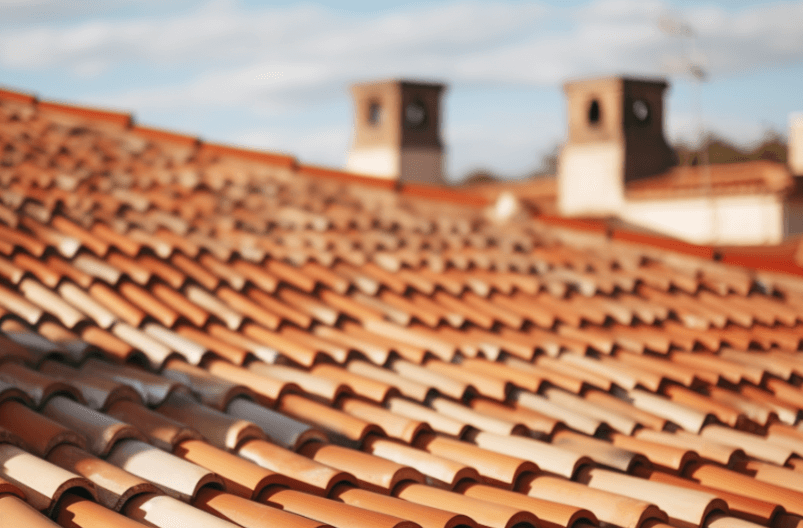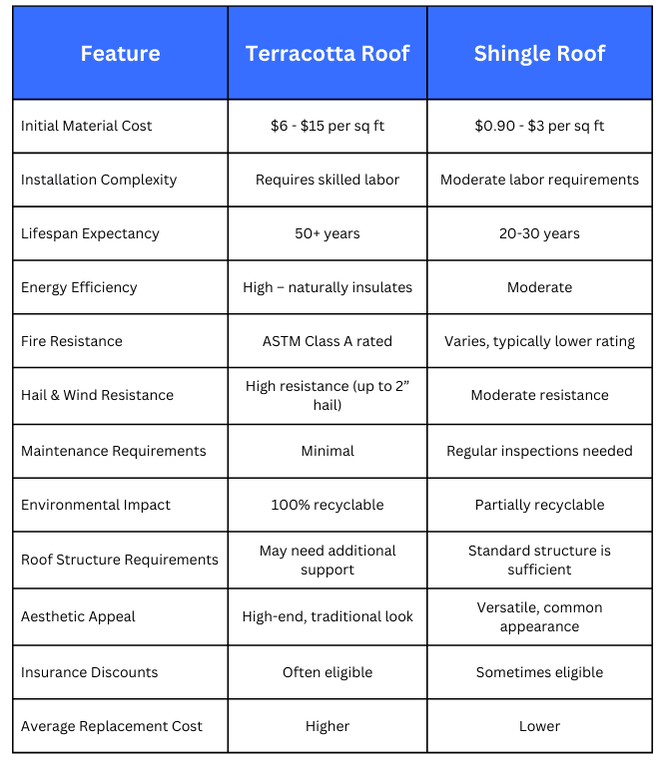
Roofing decisions are pivotal for homeowners, both in terms of aesthetics and functionality. Terracotta roofing and asphalt shingles stand out as two prominent choices, each with its distinct advantages. In this article, we’ll look at the differences of these materials, focusing on their costs and benefits. While our estimates are based on averages from suburbs in Texas, it’s essential to consult local suppliers or contractors for precise figures tailored to specific locations.
Terracotta Roofing: An Overview
Terracotta – the very word evokes images of rustic, sun-baked tiles adding charm to Mediterranean or Spanish-style homes. Derived from the Italian words for “baked earth,” terracotta has been a favored roofing material for centuries.
Benefits
- Longevity: Terracotta tiles are known for their durability, often outlasting the very structures they cover.
- Aesthetics: Their rich, earthy tones can enhance the architectural appeal of a home, offering a timeless look.
- Energy Efficiency: Terracotta’s natural properties help regulate indoor temperatures, making homes cooler in summer and warmer in winter.
Common Styles
Terracotta tiles come in various styles, with the most popular being:
- Spanish: Characterized by their “S” shape, they offer a classic Mediterranean look.
- Mission: These are semi-cylindrical tiles, often seen on mission-style homes.
- Italian: Flatter than their counterparts, Italian tiles offer a more streamlined appearance.
Shingles (Asphalt): An Overview
Asphalt shingles are a staple in American homes, prized for their affordability and versatility. Comprising a fiberglass base topped with mineral granules and asphalt, these shingles are both durable and adaptable to various architectural styles.
Benefits
- Affordability: Among the most cost-effective roofing materials, asphalt shingles offer homeowners a balance between cost and performance.
- Versatility: Available in a plethora of colors and styles, they can mimic the appearance of more expensive materials like wood or slate.
- Ease of Installation: Lighter than terracotta and requiring no specialized tools, asphalt shingles can be installed relatively quickly.
Common Styles
Asphalt shingles come in a range of styles to suit different aesthetic preferences:
- 3-Tab: These are the traditional, flat shingles that have been in use for decades.
- Architectural: Also known as dimensional shingles, they offer a layered look, adding depth and character to roofs.
- Premium: These high-end shingles are designed to replicate natural materials, offering enhanced aesthetics and durability.

Cost Breakdown: Terracotta Roofing in Texas
Material Costs
Terracotta, known for its durability and aesthetic appeal, is a premium roofing material. In suburbs of major Texas cities, the cost of terracotta tiles can range from $6 to $15 per square foot, depending on the quality, style, and brand. This price can be influenced by the intricacy of the tile design and whether they’re hand-made or machine-made.
Installation Costs
Installing terracotta tiles requires skilled labor due to the weight of the tiles and the need for precision. Installation can range from $8 to $10 per square foot. This cost encompasses labor, additional materials like underlayment, battens, and fasteners, and any specialized tools or equipment needed.
Maintenance and Potential Repair Costs
While terracotta roofs are known for their longevity, they aren’t entirely maintenance-free. Over time, tiles may need to be replaced due to breakage or wear. Individual tiles can cost anywhere from $10 to $50, depending on their design and quality. Periodic inspections, cleaning, and sealing can add to maintenance costs, but these are typically minimal compared to the roof’s lifespan.
Long-term Value
Terracotta roofs can last over 50 years, and in some cases, even up to a century with proper care. This durability means homeowners can expect fewer replacement costs over the life of the roof. Additionally, the aesthetic appeal and energy efficiency of terracotta can increase a home’s resale value. The natural properties of terracotta help in regulating indoor temperatures, potentially reducing energy bills, especially in the hot Texas climate.
Cost Breakdown: Shingles (Asphalt) in Texas
Material Costs
Asphalt shingles are among the most cost-effective roofing materials available. On average, homeowners can expect to pay between $90 to $120 for a square (which covers 100 square feet) of standard 3-tab shingles. Architectural or dimensional shingles, as well as premium shingles (designed to replicate the look of natural materials like wood or slate) vary widely and can cost upwards of $500 per square.
Installation Costs
The installation of asphalt shingles is generally less labor-intensive than terracotta, leading to lower labor costs. On average, homeowners can expect installation costs to range from $200 to $350 per square. This includes the labor, underlayment, flashing, and other necessary materials. Factors such as the complexity of the roof’s design, removal of old roofing, and any additional protective layers can influence the final installation cost.
Maintenance and Potential Repair Costs
Asphalt shingles require periodic maintenance to ensure their longevity. Regular inspections, especially after severe weather events, are crucial. Damaged or lifted shingles should be replaced promptly to prevent leaks. Fortunately, individual shingles are relatively inexpensive and easy to replace. Maintenance might also include cleaning to remove algae or moss and ensuring proper attic ventilation to prevent shingle warping.
Long-term Value
While asphalt shingles typically have a shorter lifespan than terracotta—often lasting 20 to 30 years with proper care—they offer a cost-effective solution for homeowners. Their initial affordability, combined with the variety of styles and colors available, makes them a popular choice for many. When considering resale value, a well-maintained asphalt shingle roof can still be an attractive feature for potential buyers.
Factors Influencing Costs
Every roofing project comes with its own set of challenges and considerations. The final cost isn’t just about the material you choose, but also the intricacies of your roof’s design. Roofs with multiple peaks, valleys, or additional features like skylights and chimneys often require more labor and materials, leading to increased costs.
Additionally, the type of underlayment and other protective layers you opt for can influence the overall expenditure. Synthetic underlayments, for instance, might come with a higher price tag than traditional felt but could offer superior protection.
Another factor to consider is the removal of old roofing. If you’re replacing an existing roof, the costs associated with the removal and disposal of old materials can add up. Lastly, local market conditions play a role. In areas where roofing services are in high demand, you might find labor rates to be higher.
Pros and Cons: Cost vs. Value
When weighing the costs of terracotta roofing against asphalt shingles, it’s crucial to look beyond the initial investment and consider the long-term value. Terracotta, with its higher upfront cost, offers durability that can span decades, if not a century. This longevity, combined with its timeless aesthetic appeal, can enhance a property’s value and curb appeal.
On the other hand, asphalt shingles, while more affordable initially, might need replacement sooner. However, their versatility in design and ease of installation make them a popular choice for many homeowners. It’s a balance between immediate costs and the value derived over the years.
Conclusion
Choosing between terracotta roofing and asphalt shingles is more than just a financial decision; it’s about aligning with your home’s architectural style, your personal preferences, and your long-term plans for the property. Both materials have their merits, and understanding their costs in relation to their benefits can guide homeowners to make an informed choice. As always, consulting with local roofing experts and obtaining multiple quotes can ensure you get the best value for your investment.





